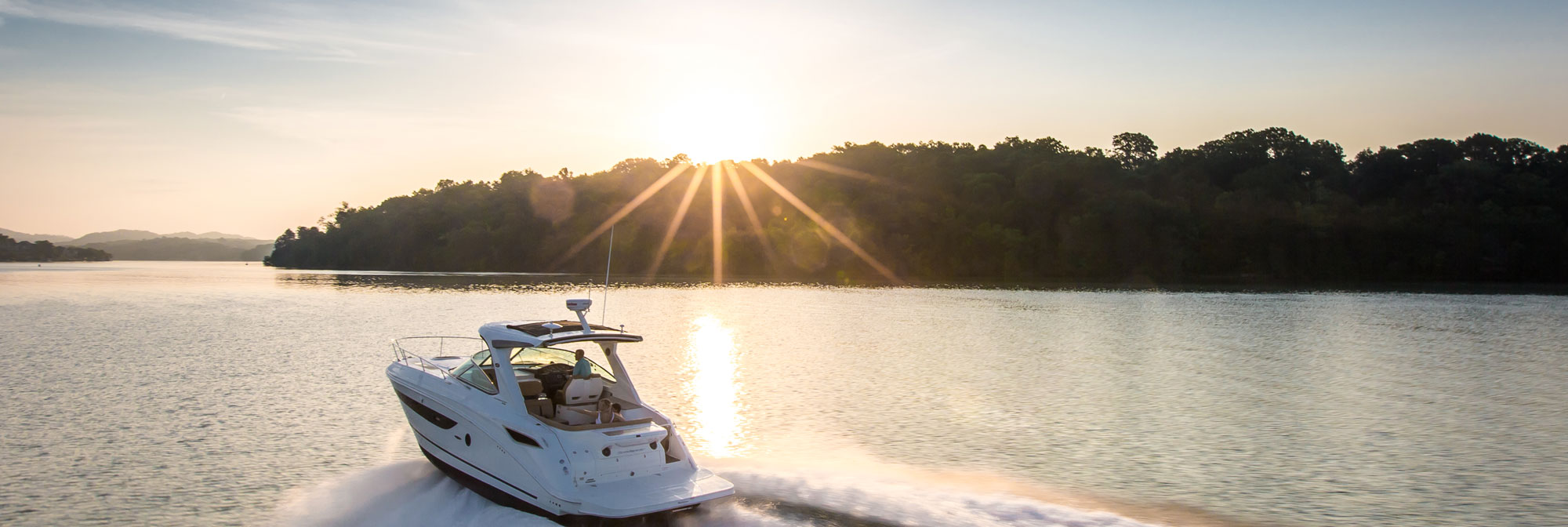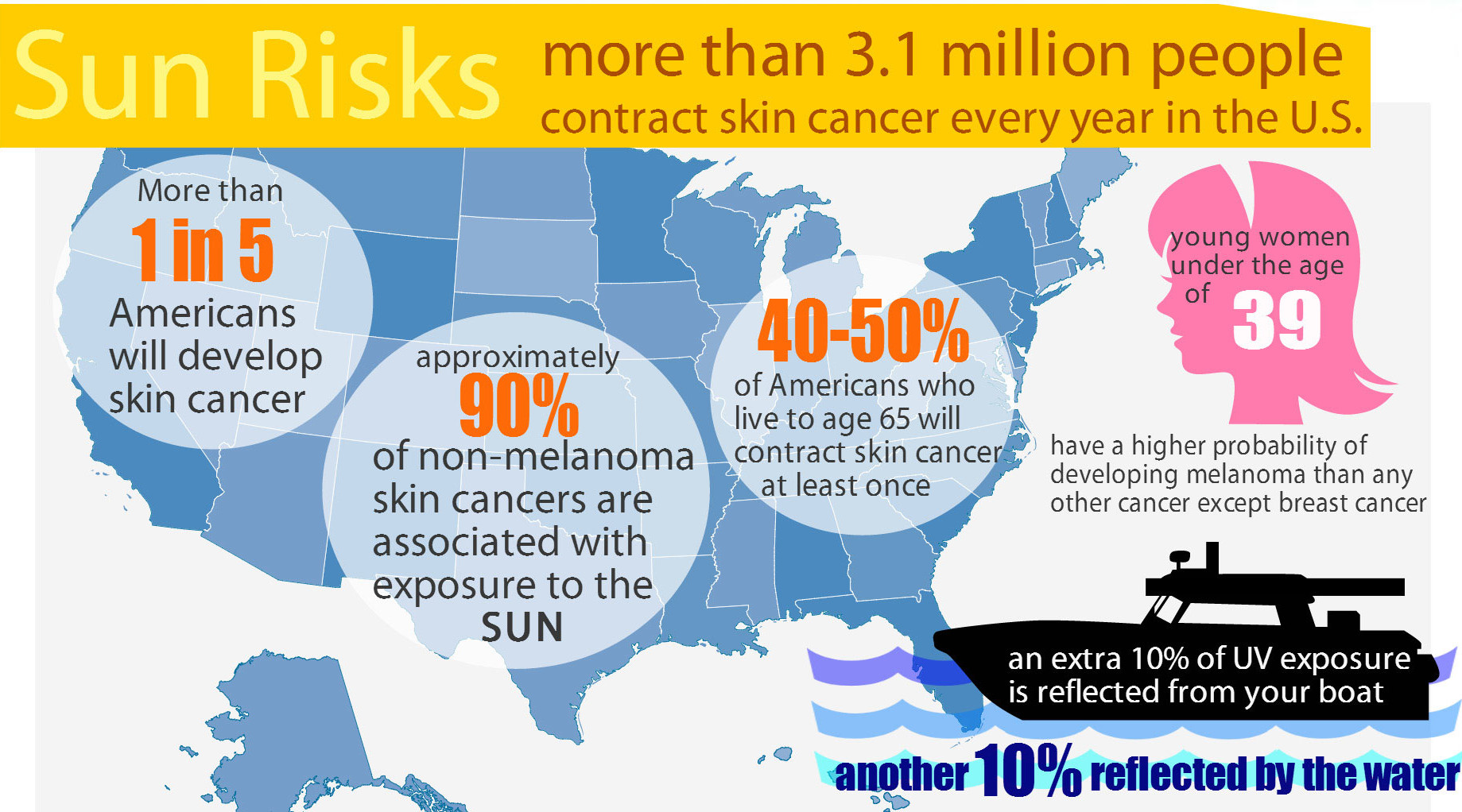
Sun Facts... and Risks
Sun safety is an often overlooked aspect of boat safety.
With fishing, cruising, tubing, anchoring, lounging, entertaining… the time you spend on your boat adds up quickly. And it only takes 20 minutes of sun exposure to get sunburn if not properly protected.
Sun Facts for Boaters:
- The average boater spends 5.7 hours on the water per outing
- Prime boating times typically correspond with peak UV exposure times (10 a.m. to 3 p.m.)
- 46.8% of boaters enjoy SUNBATHING as part of their recreational boating activities
- UV rays can reflect from the water and fiberglass boats and damage your skin – even on cloudy days!
Sun Risks
While some exposure to sunlight can be enjoyable, too much can be dangerous. Overexposure to ultraviolet (UV) radiation from the sun can result in a painful sunburn. It can also lead to more serious health problems, including skin cancer, premature aging of the skin, cataracts and other eye damage, and immune system suppression. And children are particularly at risk.
Most people are not aware that skin cancer, while largely preventable, is the most common form of cancer in the United States. More than 3.5 million new cases of skin cancer are diagnosed annually.
Skin Cancer
Each year, more new cases of skin cancer are diagnosed in the U.S. than new cases of breast, prostate, lung, and colon cancer combined. One in five Americans will develop skin cancer in their lifetime. One American dies from skin cancer every hour.
Unprotected exposure to UV radiation is the most preventable risk factor for skin cancer.
Melanoma
Melanoma, the most serious form of skin cancer, is now one of the most common cancers among adolescents and young adults ages 15-29. While melanoma accounts for about three percent of skin cancer cases, it causes more than 75 percent of skin cancer deaths. UV exposure and sunburns, particularly during childhood, are risk factors for the disease. Not all melanomas are exclusively sun-related—other possible influences include genetic factors and immune system deficiencies.
Non-melanoma Skin Cancers
Non-melanoma skin cancers are less deadly than melanomas. Nevertheless, they can spread if left untreated, causing disfigurement and more serious health problems. There are two primary types of non-melanoma skin cancers: basal cell and squamous cell carcinomas. If caught and treated early, these two cancers are rarely fatal.
Basal Cell Carcinomas are the most common type of skin cancer tumors. They usually appear as small, fleshy bumps or nodules on the head and neck, but can occur on other skin areas. Basal cell carcinoma grows slowly, and it rarely spreads to other parts of the body. It can, however, penetrate to the bone and cause considerable damage.
Squamous Cell Carcinomas are tumors that may appear as nodules or as red, scaly patches. This cancer can develop into large masses, and unlike basal cell carcinoma, it can spread to other parts of the body.
Other Skin Damage
Other UV-related skin disorders include actinic keratoses and premature aging of the skin. Actinic keratoses are skin growths that occur on body areas exposed to the sun. The face, hands, forearms, and the “V” of the neck are especially susceptible to this type of lesion. Although premalignant, actinic keratoses are a risk factor for squamous cell carcinoma. Look for raised, reddish, rough-textured growths and seek prompt medical attention if you discover them.
Chronic exposure to the sun also causes premature aging, which over time can make the skin become thick, wrinkled, and leathery. Since it occurs gradually, often manifesting itself many years after the majority of a person’s sun exposure, premature aging is often regarded as an unavoidable, normal part of growing older. However, up to 90 percent of the visible skin changes commonly attributed to aging are caused by the sun. With proper protection from UV radiation, most premature aging of the skin can be avoided.
Immune Suppression
Scientists have found that overexposure to UV radiation may suppress proper functioning of the body’s immune system and the skin’s natural defenses. For example, the skin normally mounts a defense against foreign invaders such as cancers and infections. But overexposure to UV radiation can weaken the immune system, reducing the skin’s ability to protect against these invaders.
Learn More about Sun Safety on Boats
Stay Updated on the Latest
Get the latest resources & news from Sun Safe Boating - subscribe to our email list.
SOURCES:
EPA.ORG - Health Effects of Overexposure to the Sun
American Cancer Society
The Skin Cancer Foundation
2012 USCG Recreational Boating Survey (Sun Facts for Boaters)

